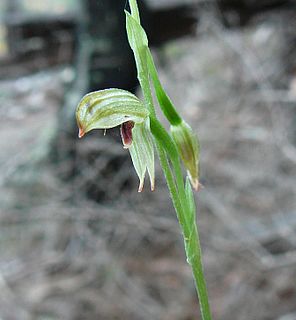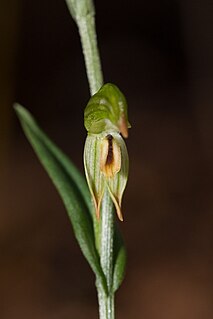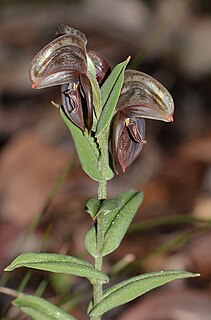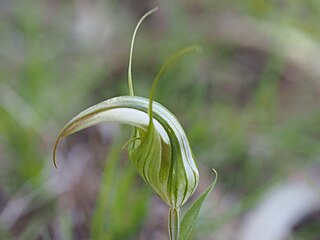
Pterostylis longifolia, commonly known as the common leafy greenhood or tall greenhood, is a plant in the orchid family Orchidaceae and is endemic to eastern Australia. Flowering plants have up to seven flowers which are green, partly transparent and which have a labellum which is pale green and hairy with a blackish central stripe. Non-flowering plants have a rosette of leaves but flowering plants lack the rosette, instead having five to eight stem leaves. A similar species, Pterostylis melagramma has paler green flowers which have a less hairy labellum.

Pterostylis atrans, commonly known as the dark-tip greenhood or blunt-tongue greenhood, is a species of orchid endemic to south-eastern Australia. As with similar greenhoods, plants in flower differ from those that are not flowering. The non-flowering plants have a rosette of leaves flat on the ground, but the plants in flower have a single flower with leaves on the flowering spike. In this species, the flower is green and reddish brown with a protruding sinus and small club-like tips on the ends of the lateral sepals.

Pterostylis cucullata, commonly known as the leafy greenhood, is a plant in the orchid family Orchidaceae and is endemic to south-eastern Australia. It has a rosette of fleshy leaves at its base and a single white, green and reddish-brown flower.

Pterostylis macilenta is a plant in the orchid family Orchidaceae and is endemic to the Grampians National Park in Victoria. As with similar greenhoods, the flowering plants differ from those which are not flowering. The non-flowering plants have a rosette of leaves flat on the ground but the flowering plants have up to six translucent, dark green flowers and lack a rosette.

Pterostylis bicolor, commonly known as the black-tip greenhood, is a plant in the orchid family Orchidaceae and is endemic to south-eastern Australia. It has a rosette of leaves and when flowering, three to ten well-spaced, bright green flowers with a blunt, greenish-black appendage on the labellum. It is similar to the swan orchid, Pterostylis cycnocephala but that species has a beak-like appendage and crowded flowers.

Pterostylis tunstallii, commonly known as Tunstall's greenhood or granite greenhood is a plant in the orchid family Orchidaceae and is endemic to south-eastern Australia. Flowering plants have up to ten transparent green flowers which have a dark brown, insect-like labellum with a blackish "head". Non-flowering plants have a rosette of leaves on a short stalk but flowering plants lack the rosette, instead having five to eight stem leaves.

Pterostylis jonesii, commonly known as the montane leafy greenhood, is a plant in the orchid family Orchidaceae and is endemic to a small area of south-eastern Australia. Individual plants have either a rosette of three to six leaves or a flowering spike with up to eleven flowers and five to seven stem leaves. The flowers are translucent green with faint darker green lines and have a brownish-yellow labellum with a dark stripe.

Pterostylis concava, commonly known as the pouched greenhood or cupped banded greenhood, is a plant in the orchid family Orchidaceae and is endemic to the south-west of Western Australia. The plants either have a rosette of leaves in the years when not flowering or stem leaves on a flowering spike. When flowering, it has up to ten or more flowers which are dark reddish-brown, sometimes green and white with deeply cupped lateral sepals. It is an uncommon orchid, mostly found between Bindoon and Mount Barker.
Pterostylis leptochila, commonly known as the Ravensthorpe rufous greenhood or narrow-lipped rustyhood is a plant in the orchid family Orchidaceae and is endemic to the south-west of Western Australia. Both flowering and non-flowering plants have a relatively large rosette of leaves. Flowering plants also have up to five large translucent white flowers with olive green and brown lines and markings and a narrow, insect-like labellum.
Pterostylis macrocalymma, commonly known as the large-hooded rufous greenhood or Murchison rustyhood is a plant in the orchid family Orchidaceae and is endemic to the south-west of Western Australia. Both flowering and non-flowering plants have a relatively large rosette of leaves. Flowering plants also have up to ten or more white flowers with bold green or pale brown lines and a broad spoon-shaped, insect-like labellum.
Pterostylis macrosepala is a plant in the orchid family Orchidaceae and is endemic to New South Wales where it grows on the central-west slopes. As with similar greenhoods, the flowering plants differ from those which are not flowering. The non-flowering plants have a rosette of leaves flat on the ground but the flowering plants have up to eight translucent green flowers with narrow, dark green stripes and up to ten stem leaves.
Pterostylis parca commonly known as the Lithgow leafy greenhood is a plant in the orchid family Orchidaceae and is endemic to New South Wales. Non-flowering plants have a rosette of leaves on a short stalk. Flowering plants lack a rosette but have up to eight translucent pale green flowers on a flowering stem with three to six stem leaves.

Pterostylis prasina, commonly known as the mallee leafy greenhood, is a plant in the orchid family Orchidaceae and is endemic to southern continental Australia. Non-flowering have a rosette of leaves on a short stalk, but flowering plants lack the rosette and have up to eight pale green and translucent green flowers with darker green lines. The flowers have a pale green labellum with a darker central line. It is a common and widespread greenhood in parts of Victoria and South Australia.
Pterostylis pulchella, commonly known as the waterfall greenhood, escarpment greenhood or pretty greenhood is a species of orchid endemic to New South Wales. As with similar greenhoods, the flowering plants differ from those that are not flowering. The non-flowering plants have a rosette of leaves flat on the ground but the flowering plants have a single flower with leaves on the flowering stem. This greenhood has a reddish-brown flower with a greenish-white base and protuding labellum with a cleft tip.

Pterostylis reflexa, commonly known as the dainty greenhood, is a species of orchid endemic to New South Wales. As with similar greenhoods, the flowering plants differ from those which are not flowering. The non-flowering plants have a rosette of leaves flat on the ground but the flowering plants have a single flower with leaves on the flowering stem. This greenhood has a relatively large white, green and light brown flower with a long, curved dorsal sepal and a protruding labellum.
Pterostylis rogersii, commonly known as the curled-tongue shell orchid, is a species of orchid endemic to the south-west of Western Australia. As with similar orchids, the flowering plants differ from those which are not flowering. The non-flowering plants have a rosette of leaves but the flowering plants lack a rosette and have a single flower with leaves on the flowering spike. This greenhood usually has a white and reddish-brown striped flower with a long, curved labellum and is found along the south coast between Binningup and Esperance.
Pterostylis spathulata, commonly known as the spoon-lipped rufous greenhood or Moora rustyhood is a plant in the orchid family Orchidaceae and is endemic to the south-west of Western Australia. Both flowering and non-flowering plants have a relatively large rosette of leaves. Flowering plants also have up to ten or more white and green or brown flowers with fine, upturned tips on the lateral sepals and a spoon-shaped, insect-like labellum.
Pterostylis stenosepala, commonly known as the narrow-sepalled leafy greenhood, is a plant in the orchid family Orchidaceae and is endemic to New South Wales. Flowering plants have up to six shiny, translucent green flowers with darker green stripes. The flowers have an insect-like labellum which is green with a dark green mound on its upper end. Non-flowering plants have a rosette of leaves on a stalk, but flowering plants lack the rosette, instead having between four and eight stem leaves.
Pterostylis flavovirens, commonly known as the coastal banded greenhood, is a plant in the orchid family Orchidaceae that is endemic to South Australia. As with other similar orchids, non-flowering plants differ from those in flower. Flowering plants have up to seven pale to translucent green flowers with darker green stripes. The flowers have an insect-like labellum which is yellowish green with a slightly darker green stripe along its centre. Non-flowering plants have a rosette of leaves on a stalk, but flowering plants lack the rosette, instead having three to six stem leaves.
Pterostylis atrosanguinea, commonly known as the crowded banded greenhood, is a plant in the orchid family Orchidaceae and is endemic to the south-west of Western Australia. The plants either have a rosette of leaves in the years when not flowering or stem leaves on a flowering spike. When flowering, it has up to twenty flowers that are dark reddish to blackish brown with translucent white areas. The labellum is dark reddish black and covered with short, stiff hairs.

















